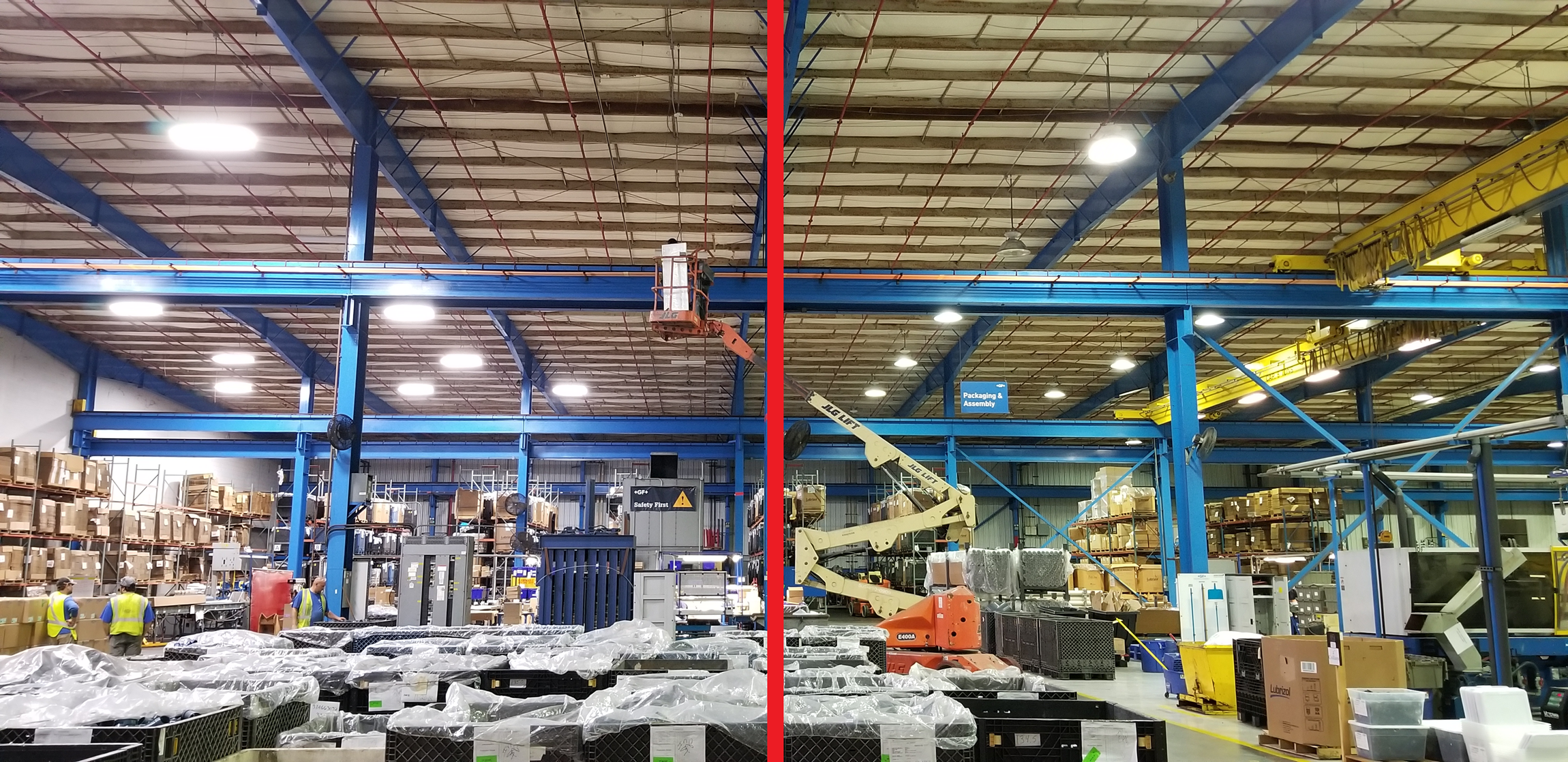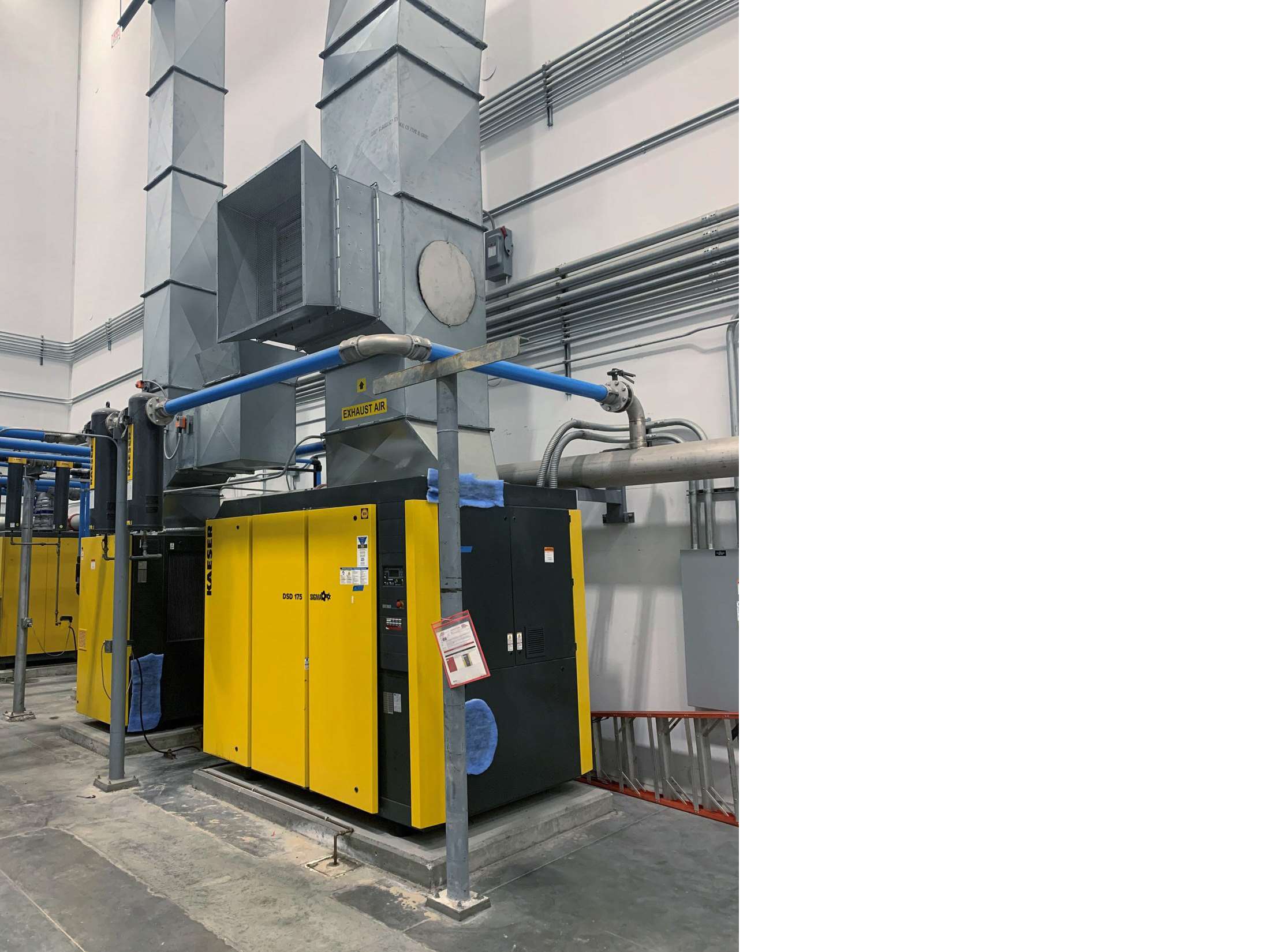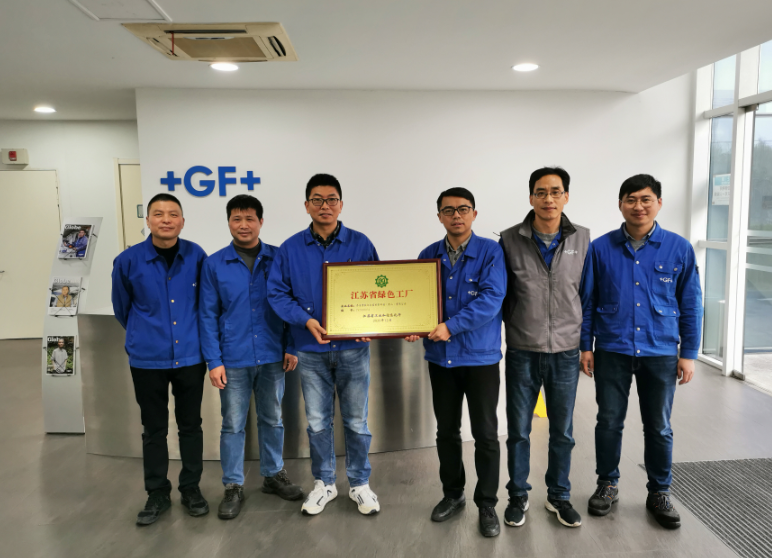Environment and energy
Environmental challenges such as climate change, the rise in energy demand, the finite nature of fossil fuels, the scarcity of raw materials, and waste disposal practices are challenging businesses to rethink their production processes and contribute toward sustainable development.
Our footprint
GF has assessed the environmental effects of its direct operations and found that energy consumption, the resulting GHG emissions, as well as the waste generated in production are the largest components of its environmental footprint.1 From a manufacturing point of view, GF’s impact on water consumption is less relevant, because most of the processes are not water-intensive. However, managing the water footprint in a sustainable way is a topic of key importance for some of GF’s stakeholders and customers. GF Piping Systems provides solutions for optimal water management, which means that GF plays a crucial role in this regard, especially in water-scarce areas.
The Sustainability Targets 2020 GF set in 2015 included environmental targets, which set GF on a journey of optimizing its manufacturing processes. These targets focused on reducing energy consumption and CO2-equivalent (CO2e) emissions, non-recycled waste, and water consumption in water-scarce areas.2 These targets were binding for all GF production facilities worldwide. A variety of measures defined since 2015 resulted in several projects being implemented to achieve the reduction targets by 2020.
In 2020, short-time work, the temporary closure of certain facilities, and a pandemic-related decrease in sales impacted environmental data. At the same time, many GF facilities continued to implement measures to improve their ecological efficiency and to reduce the overall consumption of energy and water and the generation of waste. Figures for 2020 reflect the combination of these two developments.
The GF Corporate Environmental Policy is the foundation on which GF bases its environmental management activities.
Energy and related GHG emissions
Energy consumption and related GHG emissions are of high relevance for GF based on the specifics of its business. Care needs to be taken to avoid potential negative environmental impacts. For GF’s operations, this means taking steps to consume energy more efficiently, to promote the use of renewable energy sources, and to evaluate measures to self-generate renewable energy on-site.
Climate change score from CDP
In the 2020 CDP reporting cycle, GF improved its climate change score from B to A- (Leadership level).
At year-end 2020, 84% of GF’s production facilities had environmental management systems (EMSs) in place and were certified to ISO 14001, an internationally recognized standard for such systems. Additionally, the EMSs of eight facilities of GF Piping Systems and GF Casting Solutions are certified to ISO 50001.3 These systems promote the efficient use of resources and enable the facilities to take immediate action if consumption data show significant deviations from the average. These facilities account for 49% of GF’s total energy consumption.
In addition, 90% of GF’s production facilities and a number of sales companies have in place quality management systems certified to ISO 9001 and IATF (ISO TS) 16949.
Energy consumption
In the year under review, GF’s net energy consumption decreased by 13.2% (2.5% pro rata) to 3.1 million gigajoules (GJ), while the order intake decreased by 14.4% relative to 2019.4 Although COVID-19-related measures contributed to this decline, it was mainly driven by a 14.0% year-on-year decrease in electricity consumption (3.8% pro-rata). Various small- to medium-size energy saving projects contributed to the reduction.
Beyond the aforementioned factors, a number of organizational changes made in 2019 influenced GF’s energy consumption and other environmental KPIs in 2020. For example, GF Machining Solutions’ new building in Biel (Switzerland) meets advanced energy-efficiency standards and contributed significantly to the division’s energy efficiency index in 2020. At the same time, two facilities in the United States and China increased their production capacity, resulting in higher energy consumption.
GF’s Sustainability Targets 2020 included increasing energy efficiency and reducing GHG emissions, both by 10%. During the last five years, the three divisions’ production facilities implemented 100 energy-efficiency projects, 20 of them in 2020.
GF Piping Systems’ sites in Little Rock and Bakersfield (both in the USA) implemented a range of energy-efficient lighting projects throughout their facilities. These projects achieved annual electricity savings of 560 MWh and 244 MWh respectively, which represents a reduction of 3.5% of the corresponding GHG emissions and 3.5% of the facilities’ total annual energy consumption.

GF Casting Solutions’ facility in Mills River (USA) also implemented a number of environmental improvement measures in 2020. One of them was a larger heat capturing project. In the third quarter of the year, a new device was installed to reuse and distribute the heat to the compressor room and the tooling shop. This measure contributes to the reuse of 108 MWh annually. The second device will be installed in 2021, which is expected to deliver additional savings.

In Kunshan (China), the GF Casting Solutions site was rewarded with a “Green Plant” certification for its efforts to meet a strict environmental standard set by the Chinese government. The measures implemented at the facility in the areas of energy, land, and materials use, waste management, and clean production impressed the team of external experts and government assessors. GF’s Kunshan facility was one of the first in the Juangsu province to be granted the “Green Plant” designation.

Composition of energy sources
Besides the amount of energy consumed, the composition of energy sources is equally relevant to GF’s environmental footprint.
GF Casting Solutions’ strategic shift in recent years to exit the European iron-casting business was the main contributor to the change in energy composition from 2018 to 2020. Since 2014, lignite is no longer used in GF operations and therefore not shown in graphs anymore.5
Energy sources 2020
In 1’000 GJ
Renewables met 17% of GF’s total energy consumption in 2020 (up from 15% in 2019). The vast majority (95%) was due to the purchase of 504’300 GJ of renewable electricity, primarily from hydro power and wind turbines. The remainder of the renewable energy was self-generated hydro and solar power as well as purchased renewable district heat.6
Renewable energy (incl. certified green electricity)
In %
Renewable energy sources
In %
To increase the share of renewables in GF’s energy mix, GF Casting Solutions purchased green electricity for the years 2020-2024 for its facilities in Austria, as well as for 2020 for its site in Suzhou (China). Two GF Piping Systems facilities in the United States and China started to install rooftop solar panels. The solar panels in China already meet 11% of the facility’s total electricity consumption. Currently, seven GF facilities generate their own solar or hydro power, while the majority of GF’s renewable energy is purchased.
In the year under review, GF created a green electricity fund in Switzerland with the aim of insourcing the amount spent for renewable electricity certificates. Its facilities there pay an internal GF charge and can submit proposals for subsidies from the fund for energy-efficiency measures and the self-generation of renewable energy. Based on the experience in Switzerland, in 2021, GF will assess whether to extend to fund to other countries.
For the next five years, exploring ways to substitute electricity and fossil fuels with renewable sources will remain a high priority on GF’s agenda. Several assessments were conducted in 2020 with the goal of implementing resulting initiatives as part of the Sustainability Framework 2025.
Target achievement: energy efficiency
Energy efficiency index
Production volume7per energy consumption
Target line
Over the last five years, GF met its energy-efficiency target, which was made possible thanks to positive contributions of the three divisions.8
GF’s production output and energy consumption declined in 2020. Energy efficiency declined slightly year-on-year, but the trend was still in line with the 2020 target. The reason was that many facilities gradually reduced production capacity in the first half of 2020 (due to COVID-19), whereas energy consumption did not decrease at the same pace. A production facility not operated at full capacity generally has a lower efficiency.
As in the previous years, in 2020, GF organized a virtual sustainability conference to promote cross-facility and cross-divisional information sharing on energy efficiency and other topics.
2020 marked the end of the Sustainability Targets 2020. Consequently, GF evaluated the measures it had implemented over the five-year period and assessed their contribution to target achievement. One of the new targets for 2025 focuses on reducing GHG emissions by 12.5% over the next five-year period compared with the baseline. To achieve this ambitious target will require a combination of energy-efficiency measures and a clear strategy on renewable energy. GF’s Corporate Sustainability Team, in close collaboration with the divisions and the facilities, is working on developing a roadmap to achieve this target by the end of 2025.
Emissions
Total GHG emissions
In 1’000 tonnes
GF distinguishes between the sources of its GHG emissions to better contribute to the international community’s efforts to meet the goals of the Paris Agreement.
Total GHG emissions decreased by 17% in 2020 (11% pro rata). Scope 1 emissions decreased by 12% year-on-year (0% pro rata).9 Scope 2 market-based emissions declined by 18% (11% pro rata).10 Scope 3 emissions fell by 67%. Currently, GF’s Scope 3 emissions calculation consists only of business travel, which declined significantly due to COVID-19 travel restrictions in place in 2020.
The majority (76%) of GF’s GHG emissions stem from electricity consumption and are classified as Scope 2 emissions. The remaining 24% consists of Scope 1 emissions resulting from the consumption of fossil fuels at GF’s operations (over 23%) and Scope 3 emissions from business travel (less than 1%).
In the year under review, GF Casting Solutions invested in Guarantees of Origin for its facilities in Austria and for one site in China.11 The purchase covered 37% of the division’s electricity consumption and contributed positively to reducing GF’s overall Scope 2 emissions. Additionally, GF Piping Systems partnered with Land Life Company to offset the Scope 1 footprint of three of its American sites by planting 14’000 trees in California, Texas, and Oregon.
Target achievement: CO2e emissions
GHG emissions intensity index
CO2e emissions per production volume7
Target line
In the year under review, GF achieved the target GHG intensity line. Compared to 2019, more Guarantees of Origin were purchased, however this could not fully compensate for the drop in the production volume.
GF achieved its five-year GHG emission intensity target. Absolute GHG emissions in 2020 were 16% lower than the baseline. This is mainly attributable to the energy-efficiency contributions by GF Piping Systems (around 33%) and Casting Solutions (around 65%). The impact of GF Machining Solutions accounted for around 2%.
For the next five-year strategy, GF aims to decrease its GHG emissions by 12.5% compared to the baseline, a reduction trajectory in line with the Science-Based Targets initiative (SBTi).12 As GF does not yet report comprehensively on its Scope 3 emissions, a project is underway to quantify 10 of the 15 relevant Scope 3 emissions categories. Based on the findings, GF will set a reasonable reduction target for its customers and suppliers. GF plans to submit its targets to SBTi for approval in 2022.
Natural resources and materials
Ensuring prudent and responsible resource and waste management is important for GF. It therefore aims to redesign its production processes in a holistic way in order to close material loops. In principle, the castings of GF Casting Solutions are 100% recyclable whether they are made of aluminum or magnesium, and these materials are reused in a circular fashion. Additionally, GF integrates re-use opportunities when retrofitting its buildings. Identifying options for recycling and for applying circular economy approaches to the materials used by the other two divisions is on GF’s sustainability agenda.
Waste materials from production processes can be used as a resource for other industrial companies and therefore reduce the overall demand for energy and raw materials. Examples include using GF’s manufacturing by-products as a substitute for fossil fuels or as an input for the production of cement. GF is constantly on the outlook for such opportunities.
In the year under review, the total amount of waste decreased by 17% (9% pro rata). The share of hazardous waste increased from 9% to 12%, with 88% of the total waste being non-hazardous. The increase in hazardous waste was mainly due to technical problems at one GF Casting Solutions site. During the manufacturing process, oil is mixed with water. Before releasing the water from the emulsion, a machine separates both materials. As a result, the oil is disposed of as hazardous waste and the water is released to the local sewage systems. During 2020, the machine that separates the emulsion had technical issues. Consequently, the total amount of the oil-water emulsion was disposed of as hazardous waste. The site has fixed the issue. Hazardous waste is therefore expected to decline in subsequent years. The majority of GF’s waste is recycled (71%).
Other initiatives that focus on both the sourcing of reusable materials and components as well as on revising GF’s waste management processes to enable reuse are on the three divisions’ agenda.
Waste disposal
In tonnes
Composition of waste
In tonnes
Target achievement: unrecycled waste13
Unrecycled waste intensity index
Unrecycled waste per production volume7
Target line
Although absolute waste volumes decreased during 2020, the production volume decreased at a higher pace, which led to GF not achieving its unrecycled waste target.
The Sustainability Framework 2025 places a major emphasis on finding ways to improve the disposal of GF’s waste. The 2025 target aims to decrease waste sent to landfill and incineration by 20% compared with baseline.
Six production facilities of GF Casting Solutions and two production facilities of GF Piping Systems account for 95% of GF’s total hazardous waste. The Corporation will set a target to reduce these eight facilities’ hazardous waste by 2025.
Water footprint
Water is essential to life, so good stewardship of this finite resource is important to GF. One of GF’s Sustainability Targets 2020 was therefore to consume 10% less water in water-stressed and water-scarce areas by 2020. In early 2017, an analysis was conducted of GF production facilities which are located in water-stressed areas, using the World Resources Institute (WRI) tool.14 The GF water target for 2020 was relevant for the six sites (all are part of GF Piping Systems). Three are in China and three in the United States. These facilities monitored their water consumption carefully over the past five years and implemented improvement measures accordingly.
Water security score from CDP
In the 2020 CDP reporting cycle, GF improved its water security score from B to A- (Leadership level).
In general, GF production facilities do not consume large amounts of water. They use is it in closed-loop cycles for cooling purposes. The majority of the water is discharged to municipal wastewater treatment systems. All production sites comply with applicable laws and regulations governing wastewater discharge. Furthermore, GF Casting Solutions sites comply with additional wastewater-discharge requirements. In prior years, a GF Piping Systems site in Dallas (USA) lost water because of a faulty system in a chiller. After replacing the old single compressor system with a new dual one, this facility’s water consumption decreased by 2’259 m³ (10.6%) in 2020.
Water consumption
In 1’000 m³
Another GF Piping Systems site, in Indonesia, fixed its leakages in several areas and was able to reduce its water consumption in 2020 by 3’639 m³ (15.2%).
The total water consumption for all GF facilities decreased by 17% in 2020 compared with 2019 (13% pro rata). The reduction reflects in part the improvement measures realized by the facilities.
Target achievement: water in water-stressed areas
Water intensity index
Water consumption per production volume7
GF’s production plants located in water-stressed areas reduced their water consumption beyond the targeted reduction path of 2% per year. Compared with the baseline, the facilities reduced their overall water consumption by 9%.
In the year under review, one facility of GF Piping Systems’ Chinaust joint venture optimized its cooling cycle and the overall water consumption on site, which contributed to an 18% reduction in water usage relative to 2019. The site is one of GF’s large water consumers, so the reduction helped achieve the target in 2020.
For the strategy cycle 2025, GF set a goal to reduce water intensity by 20% in the areas with high water stress compared with the baseline. This target is binding for a total 15 facilities across all three divisions. GF again used the WRI water aqueduct tool to determine which of its facilities are located in a water-stressed area.